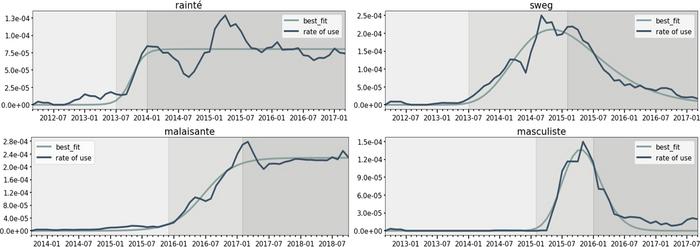The more centrally connected someone is within their social media network, the more likely that new words they use will become adopted into mainstream language, according to a new study published this week in PLOS Complex Systems by Louise Tarrade of École Normale Supérieure, France, and colleagues.

Credit: Tarrade et al., 2024, PLOS Complex Systems CC-BY 4.0 (
The more centrally connected someone is within their social media network, the more likely that new words they use will become adopted into mainstream language, according to a new study published this week in PLOS Complex Systems by Louise Tarrade of École Normale Supérieure, France, and colleagues.
Language evolves within a social context and variations in a language are always in competition with each other. In everyday language, words are constantly being created, but not all these words persist.
In the new study, researchers analyzed more than 650 million tweets written in French between 2012 and 2014 to identify 400 words that were new to appear in the social media network X (then called Twitter) during that time. Then, they tracked the diffusion of these words over the following five years, and looked at the position and connectivity of users who adopted the words.
The team found that initial adopters of new words, or “lexical innovations” are similar to each other, regardless of whether the innovations later succeed (as language changes) or fade away (as temporary buzzes). However, in the later propagation phase for lexical innovation, there were statistically significant differences between changes and buzzes. On average, the words that eventually persisted were used by people who were more central to their community, and remained in circulation at low levels for a longer period before entering a growth phase (18.5 months in circulation compared to 6.5 months for buzzes). Words that became only temporary buzzes were used by people with less central positions within a social network and had a more rapid rise in use – followed by a rapid decline.
“Our research examines lexical innovations at scale across millions of social media users,” the authors say. “We show that words adopted by users who are more central in their community and easily in contact with other communities become established in the language, and vice versa. Thus, the position in the network of speakers who adopt these words is enough to predict their fate.”
The authors add: “Doing sociolinguistics with digital data and computational methods offers the opportunity to scale up and reveal social dynamics at the population level.”
############
In your coverage, please use this URL to provide access to the freely available article in PLOS Complex Systems:
Citation: Tarrade L, Chevrot J-P, Magué J-P (2024) How position in the network determines the fate of lexical innovations on Twitter. PLOS Complex Syst 1(1): e0000005.
Author Countries: France
Funding: J.-P. M., J.-P. C. and L.T. are grateful to the ASLAN project (ANR-10-LABX-0081, of the Université de Lyon for its financial support within the French program “Investments for the Future” operated by the National Research Agency (ANR). The data collection has been supported by the SoSweet ANR project (ANR-15-CE38-0011-03, attributed to J.-P. M. and J.-P. C. The authors are also grateful to University of Grenoble Alpes and Ecole Normale Supérieure de Lyon for the support for publication. The funders had no role in study design, data collection and analysis, decision to publish, or preparation of the manuscript.
Journal
PLOS Complex Systems
Method of Research
Observational study
Subject of Research
People
COI Statement
Competing Interests: The authors have declared that no competing interests exist.



